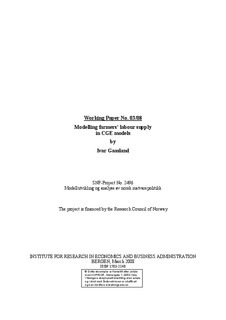| dc.contributor.author | Gaasland, Ivar | |
| dc.date.accessioned | 2008-05-15T08:02:32Z | |
| dc.date.available | 2008-05-15T08:02:32Z | |
| dc.date.issued | 2008-03 | |
| dc.identifier.issn | 1503-2140 | |
| dc.identifier.uri | http://hdl.handle.net/11250/166124 | |
| dc.description.abstract | In most CGE models with special focus on farm policy, the on-farm wage either follows the ordinary wage in the economy or it is varies according to an assumption of sector specific farm labour. This paper demonstrates a practical and empirical consistent way to model farm household allocation of labour in CGE models, assuming that farm labour is partially sector specific. In this set up, preferences for farming and the relative wage between on-farm and off-farm work, determines the allocation of farm household labour between on-farm and off-farm work. Reallocation of labour as a response to change in relative wage, is assumed to be sluggish. Using the Norwegian agricultural sector as a case, the paper demonstrates clearly that the farmers’ preferences for on-farm work are of vital importance as to how a liberalisation of farm policy affects farm output and farmers’ income. The results depend on technology; i.e. to what degree costs can be reduced by replacing hired labour, capital and other factors with cheaper family labour. Technology is especially important when preferences for on-farm work are high, i.e. when farmers accept to work at their own farm even if the wage falls substantially. | en |
| dc.language.iso | eng | en |
| dc.publisher | SNF | en |
| dc.relation.ispartofseries | Working paper | en |
| dc.relation.ispartofseries | 2008:03 | en |
| dc.title | Modelling farmers' labour supply in CGE models | en |
| dc.type | Working paper | en |
| dc.subject.nsi | VDP::Landbruks- og Fiskerifag: 900::Landbruksfag: 910 | en |
| dc.subject.nsi | VDP::Samfunnsvitenskap: 200::Økonomi: 210::Samfunnsøkonomi: 212 | en |
